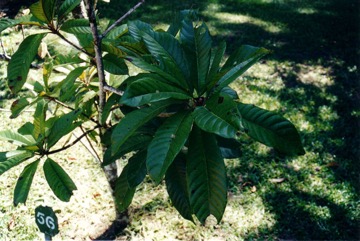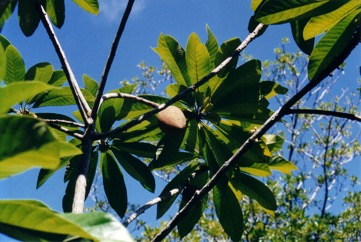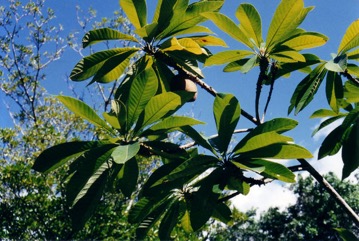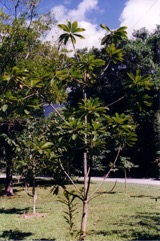Sapote, Mamey sapote

A tropical plant. It is native from Mexico to Central America. It does best in the hot humid tropical lowlands. It prefers a rainfall above 1900 mm per year. They are susceptible to frost. It cannot tolerate low temperatures. Temperatures between 25°-28°C are best. They cannot tolerate drought. It grows naturally at low elevations in Central America. Trees grow from sea level to 1400 m altitude. A distinct dry season limits the fruiting season. It suits hardiness zones 10-11.
Also known as:
Chico-mamey, Ciko mama, Green sapote, Mamei, Mamey colorado, Marmalade plum, Ngomo, Saeda, Tru'ng ga, Zapote
Synonyms
- Achras lucuma Blanco, nom. illeg.
- Achras mammosa L. (1760)
- Achras zapota L.(1753)
- Bassia jussaei Griseb.
- Bassia jussiaei Tussac
- Calocarpum huastecanum Gilly
- Calocarpum mammosum (L.) Pierre
- Calocarpum sapota (Jacq.) Merr.
- Calospermum parvum Pierre
- Lucuma bonplandii Kunth
- Lucuma mammosa auct.
- Pouteria mammosa (L.) Cronquist
- Sapota mammosa Mill.
- Sideroxylon sapota Jacq.
- Sideroxylum sapota Jacq.
Edible Portion
- Fruit, Kernel, Seeds, Nuts
Where does Sapote grow?
Found in: Asia, Australia, Barbados, Belize, Brazil, Cambodia, Central America, Colombia, Costa Rica, Cuba, Dominican Republic, East Timor, El Salvador, Fiji, Guadeloupe, Guatemala, Guiana, Guianas, Guyana, Haiti, Hawaii, Hispaniola, Honduras, Indochina, Indonesia, Israel, Jamaica, Malaysia, Martinique, Mexico, Nicaragua, North America, Pacific, Panama, Philippines, Puerto Rico, SE Asia, Sierra Leone, South America, Spain, St Lucia, Suriname, Timor-Leste, Trinidad and Tobago, United States, Venezuela, Vietnam, West Africa, West Indies
Notes: There are about 150-320 Pouteria species. They grow in the tropics.
Growing Sapote, Mamey sapote
Cultivation: Trees can be grown from fresh seed. Seeds take 40-70 days to germinate. This can be made quicker by breaking the seed coat. The best varieties are grafted. Shoots for grafting are best selected during the summer dormant period when the tree has no leaves. Plants can be grown by layering.
Edible Uses: The fruit is eaten fresh and raw or in icecream and desserts. Fruit are also dried or preserved. It is added to guava cheese and made into jam. Unripe fruit are used as a vegetable. The seeds are ground and made into a confection or a drink.
Production: Trees are slow growing. Grafted trees may bear in 1-4 years. Seedling trees take 8-10 years to fruit. Trees can continue to produce fruit for 100 years. Fruit take about 1 year to mature. A fruit can weigh 2.5 kg.
Nutrition Info
per 100g edible portion| Edible Part | Energy (kcal) | Protein (g) | Iron (mg) | Vitamin A (ug) | Vitamin c (mg) | Zinc (mg) | % Water |
|---|---|---|---|---|---|---|---|
| Fruit | 94 | 1.4 | 0.9 | - | 23 | - | 67.6 |
| Fruit | 121 | 1.7 | 1.1 | 400 | 29 | - | 65.6 |
Sapote, Mamey sapote Photos




References
Barwick, M., 2004, Tropical and Subtropical Trees. A Worldwide Encyclopedic Guide. Thames and Hudson p 344
Castaneda, H., & Stepp, J. R., 2007, Ecosystems as Sources of Useful Plants for the Guaymi People of Costa Rica. Ethnobotany Journal. 5:249-257
Coe, F. G., and Anderson, G. J., 1996, Ethnobotany of the Garifuna of Eastern Nicaragua. Economic Botany 50(1) pp 71-107
Coe, F. G. and Anderson, G. J., 1999, Ethnobotany of the Sumu (Ulwa) of Southeastern Nicaragua and Comparisons with Miskitu Plant Lore. Economic Botany Vol. 53. No. 4. pp. 363-386
Coronel, R.E., 1982, Fruit Collections in the Philippines. IBPGR Newsletter p 6 (As Calocarpum sapota)
Cruz, I. M., et al, 2015, Edible fruits and seeds in the State of Mexico. Revista Mexicana de Ciencias Agricolas. Vol. 6. Num. 2 pp 331-346
Cundall, P., (ed.), 2004, Gardening Australia: flora: the gardener's bible. ABC Books. p 1078
Darley, J.J., 1993, Know and Enjoy Tropical Fruit. P & S Publishers. p 110
FAO, 1993, Valor Nutritivo Y Usis en Alimantacion humana de Algunis Cultivos Autoctonos Subexplotados de Mesoamerica. FAO, Santiago, Chile. p 7
Food Composition Tables for use in East Asia FAO http://www.fao.org/infoods/directory No. 998
Grandtner, M. M., 2008, World Dictionary of Trees. Wood and Forest Science Department. Laval University, Quebec, Qc Canada. (Internet database http://www.wdt.qc.ca)
Hermandez Bermejo, J.E., and Leon, J. (Eds.), 1994, Neglected Crops. 1492 from a different perspective. FAO Plant Production and Protection Series No 26. FAO, Rome. p17, 103
Hibbert, M., 2002, The Aussie Plant Finder 2002, Florilegium. p 239
http://palaeoworks.anu.edu.au/Nuno_PhD/04.pdf re Timor
Ibarra-Manriquez, G., et al, 1997, Useful Plants of the Los Tuxtlas Rain Forest (Veracruz, Mexico): Considerations of their Market Potential. Economic Botany, Vol. 51, No. 4, pp. 362-376
Jardin, C., 1970, List of Foods Used In Africa, FAO Nutrition Information Document Series No 2.p 123 (As Calocarpum sapota)
John, L., & Stevenson, V., 1979, The Complete Book of Fruit. Angus & Robertson p 264
Kermath, B. M., et al, 2014, Food Plants in the Americas: A survey of the domesticated, cultivated and wild plants used for Human food in North, Central and South America and the Caribbean. On line draft. p 696
Kiple, K.F. & Ornelas, K.C., (eds), 2000, The Cambridge World History of Food. CUP p 1808
Langlois, H. C., 2004, Ethnobotanical analysis of different successional stages as sources of wild edible plants for the Guaymi people in Costa Rica. M. Sc. thesis University of Florida.
Lentz, D. L., 1993, Medicinal and Other Economic Plants of the Paya of Honduras. Economic Botany, Vol. 47, No. 4, pp. 358-370 (As Pouteria mammosa (L.) Cronquist)
Little, E. L., et al, 1974, Trees of Puerto Rico and the Virgin Islands. USDA Handbook 449. Forestry Service. p 792
Llamas, K.A., 2003, Tropical Flowering Plants. Timber Press. p 344
Lorenzi, H., Bacher, L., Lacerda, M. & Sartori, S., 2006, Brazilian Fruits & Cultivated Exotics. Sao Paulo, Instituto Plantarum de Estuados da Flora Ltda. p 621
Macmillan, H.F. (Revised Barlow, H.S., et al) 1991, Tropical Planting and Gardening. Sixth edition. Malayan Nature Society. Kuala Lumpur. p 306
Martin, F. W., et al, 1987, Perennial Edible Fruits of the Tropics. USDA Handbook 642 p 59 (As Calocarpum sapota)
Melander, M., 2007, Endangered plants on the market in Havana City, Cuba. Uppsala University, Sweden p 19
Menninger, E.A., 1977, Edible Nuts of the World. Horticultural Books. Florida p 33
Miguel, E., et al, 1989, A checklist of the cultivated plants of Cuba. Kulturpflanze 37. 1989, 211-357
Milow, P., et al, 2013, Malaysian species of plants with edible fruits or seeds and their evaluation. International Journal of Fruit Science. 14:1, 1-27
Morton, Julia F., 1987, Fruits of Warm Climates. Creative Resources Systems, Inc. . p. 398
Mutchnick, P. A. and McCarthy, B. C., 1997, An Ethnobotanical Analysis of the Tree Species Common to the Subtropical Moist Forests of the Peten, Guatemala. Economic Botany, Vol. 51, No. 2, pp. 158-183 (As Pouteria mammosa)
Pham-Hoang Ho, 1999, An Illustrated Flora of Vietnam. Nha Xuat Ban Tre. p 630
Phon, P., 2000, Plants used in Cambodia. © Pauline Dy Phon, Phnom Penh, Cambodia. p 511
Plants of Haiti Smithsonian Institute http://botany.si.edu/antilles/West Indies
PROSEA (Plant Resources of South East Asia) handbook, Volume 2, 1991, Edible fruits and nut. p 259
Purseglove, J.W., 1968, Tropical Crops Dicotyledons, Longmans. p 646
Recher, P, 2001, Fruit Spirit Botanical Gardens Plant Index. www.nrg.com.au/~recher/ seedlist.html p 3 (As Pouteria mammosun)
Sang, D. T., & Mizoue, K. O. N., 2012, Use of Edible Forest Plants among Indigenous Ethnic Minorities in Cat Tien Biosphere Reserve, Vietnam. Asian Journal of Biodiversity Vol. 3 (1), p 23-49
Smith, N., Mori, S.A., et al, 2004, Flowering Plants of the Neotropics. Princeton. p 344
Solomon, C., 2001, Encyclopedia of Asian Food. New Holland. p 330
Soerianegara, I. & Lemmens, R. H. M. L., (Eds.) 1993, Timber trees: Major commercial timbers. Plant Resources of South-East Asia. Wageningen. No. 5(1). p 363
Staples, G.W. and Herbst, D.R., 2005, A tropical Garden Flora. Bishop Museum Press, Honolulu, Hawaii. p 521
Tankard, G., 1990, Tropical fruit. An Australian Guide to Growing and using exotic fruit. Viking p 70
Taxon 16:383. 1967
USDA, ARS, National Genetic Resources Program. Germplasm Resources Information Network - (GRIN). [Online Database] National Germplasm Resources Laboratory, Beltsville, Maryland. Available: www.ars-grin.gov/cgi-bin/npgs/html/econ.pl (10 April 2000)
Usher, G., 1974, A Dictionary of Plants Used by Man. Constable. p 17 (As Achras sapota)
Van Sam, H. et al, 2008, Uses and Conservation of Plant Species in a National Park. A case study of Ben En, Vietnam. Economic Botany 62:574-593
Wickens, G.E., 1995, Edible Nuts. FAO Non-wood forest products. FAO, Rome. p153
World Checklist of Useful Plant Species 2020. Royal Botanic Gardens, Kew
www.worldagroforestrycentre.org/treedb/
Yuncker, T.G., 1940, Flora of the Aguan Valley and the coastal regions near La Ceiba, Honduras. Botany Series, Field Museum of Natural History 9(4) p 325 (As Calocarpum mammosum)
Zaldivar, M. E., et al, 2002, Species Diversity of Edible Plants Grown in Homegardens of Chibehan Amerindians from Costa Rica. Human Ecology, Vol. 30, No. 3, pp. 301-316
Zuchowski W., 2007, Tropical Plants of Costa Rica. A Zona Tropical Publication, Comstock Publishing. p 203